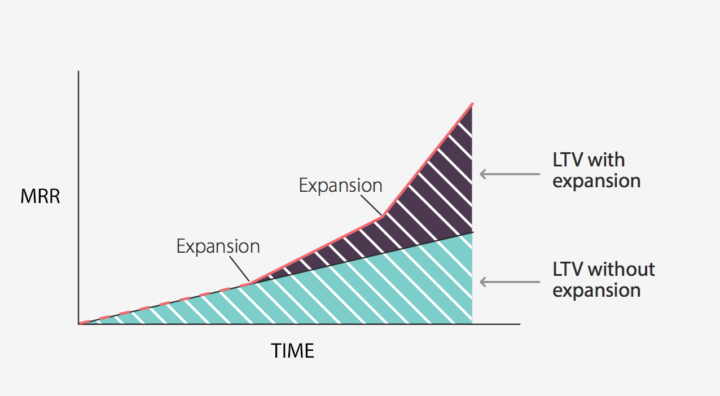Estimating LTV is tough. We’ve looked at different ways of estimating it in The Ultimate Guide to SaaS LTV, we’ve discussed the usefulness of it with the CEO of Workable, and now we’re going to discuss what you can actually do with it.
A quick recap: How to estimate LTV
Customer Lifetime Value (LTV) is an estimate of the average gross revenue that a customer will generate before they churn (cancel).
There are actually a number of different models for building an estimate of LTV; we’re just going to cover the most basic (and widely accepted) one here. If you want to study more advanced formulae, you should download and read The Ultimate Guide to SaaS LTV.
The Formula

Remember to ensure that both ARPA and Customer Churn Rate are both from the time range for which you are measuring LTV.
What to do if your Customer Lifetime Value is…
High
A high LTV is likely to make you the envy of many SaaS businesses – this frees up a lot of options for customer acquisition, and suggests that your most valuable customers are sticking around for a long time (low revenue churn).
What is “high”?
The answer to this question is fairly relative to your business, and the amount you charge for your subscriptions. As a rule of thumb for most B2B SaaS products, if your LTV is over $1000 you’re into the “fairly comfortable” range. As Close.io’s Steli Efti suggests, anything over $1000 suggests that you could look at investing in a dedicated sales team (the value is high enough to offset the investment of hiring the team).
Actions to take
A high Customer Lifetime Value opens up a variety of options to play with:
- Scaling your paid customer acquisition (provided that your Customer Acquisition Cost (CAC) remains less than 1/3rd of your LTV).
- Hiring a sales team, and adopting the “Sales-supported SaaS” model.
- Understand what’s driving the high Lifetime Value, and try to reproduce (or even exploit) this. Is it just a very low Churn Rate? Or a high Average Revenue Per Account? Look at these other metrics to get a better picture of what’s going on.
Low
As you can imagine, a low LTV can be fairly limiting. But what can you do about it?
What is “low”?
Again, this depends on the nature of your product. A LTV of less $1000 can be just fine, if your business looks more consumer-y (you have a large number of customers each contributing a low amount of revenue).
Actions to take
Firstly, find out if your Customer Churn is high, or if your Average Revenue Per Account (ARPA) is low. One of these two things will be causing low LTV.
- If you have high Customer Churn, there are some steps you can take to reduce it, such as implementing a Customer Success framework. You should read Actionable SaaS Metrics: Customer Churn Rate to find out more on churn reduction.
- If your ARPA is low, you might want to look at restructuring your product’s pricing. Can you implement scalable pricing, for example? Our analysis of SaaS Pricing pages is a good resource for this, as well as our post on Scaling SaaS Pricing for both B2B & B2C Customers.
- It’s also possible that the nature of your product leads to a lower LTV. For example, if most customers get all of the possible value from your product within a short space of time, they’re likely to churn (this is “Happy Churn”) and cause your LTV to have a fairly consistent ceiling.
Unstable
In the same way that Churn Rate can be unstable, Customer Lifetime Value is just as prone to (if not, more prone to) being unstable. For example, the simple LTV formula doesn’t account for account expansion – something that has a large impact on the overall lifetime value of a customer:

If you’re finding that the LTV you estimate varies each month by a large amount, you might want to consider the following actions:
Actions to take
- Assess whether estimating LTV is suitable for your size of business. If you have a fairly small number of customers (less than 500) then it’s likely that you’ll never be able to reliably estimate LTV without large month-to-month fluctuations.
- Consider focusing on other metrics that could be more meaningful at the current stage of your business, such as Net Promoter Score (NPS) – a leading indicator of customer satisfaction.
You could also look at changing the LTV formula you use, to account for different characteristics of your business. Here’s a modular formula suggested in The Ultimate Guide to SaaS LTV, which can account for some account expansion, as well as non-linear revenue churn:

In summary
Estimating the Lifetime Value of your customers can be highly useful for larger SaaS businesses – primarily for calculating the optimal spend on new customer acquisition (you’ll come across the CAC : LTV ratio in pretty much every SaaS publication out there). One of the main pitfalls is to focus solely on this metric, especially on cases where the value can be volatile, and therefore not useful as a basis for any action. Use with caution!
